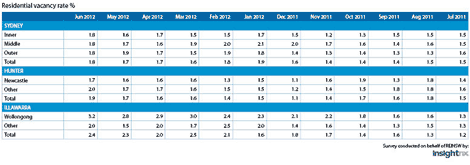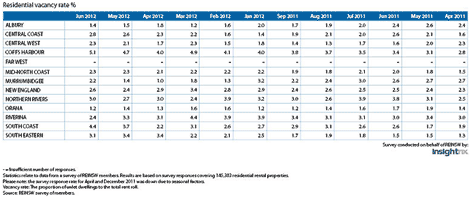Sydney's rental vacancy eases slightly but property market still favours landlords: REINSW
There was a small increase in the percentage of properties available to rent in the inner and middle suburbs of Sydney over June, according to figures compiled Real Estate Institute of NSW (REINSW).
The residential vacancy rate eased by 0.2 percentage points from 1.6% to a rate of 1.8% in the inner-Sydney suburbs (0-10km from CBD) and by 0.1 percentage points in the middle suburbs (10-25km from CBD) from 1.7%, also to a rate of 1.8%.
Rental vacancies tightened in the outer suburbs (25km or more from CBD) by 0.1 percentage point from 1.9% to match the vacancy rate in the rest of Sydney at 1.8%
The overall Sydney vacancy rate has hovered around the 1.8% mark since the start of 2012, up from 1.5% in the second half of 2011.
Despite the small improvement in the inner and middle suburbs Sydney remains an extremely tight rental market favouring landlords – according to the Real Estate Institute of Australia (REIA) a vacancy rate of 3% indicates a balanced market.
REINSW June 2012 Sydney vacancy rates
Click to enlargeOutside of Sydney all the other major metropolitan centres recorded increases in the percentage of available rental properties last month.
Wollongong recorded the strongest increase, rising 0.4 percentage points from 2.8% to 3.2%.
Newcastle increased by 0.1 percentage point to 1.7% and on the Central Coast the percentage of available properties rose by 0.2 percentage points to 2.8%.
Coffs Harbour recorded the highest rental vacancy rate of 5.1%, and the Orana District recorded the lowest in the state at 1.2%
REINSW June 2012 regional NSW vacancy rates
Click to enlarge“Wollongong continues to record vigorous growth in the number of available rental properties, which are now more than three times the 0.9% level recorded in June 2011,” says REINSW president Christian Payne.
“June did prove to be a good month for those looking to rent a property with some strong increases recorded in available properties towards the end of the financial year.”
“Nowhere is this more the case than in Wollongong, which now offers prospective tenants a wide choice of available property.
“Elsewhere across the state there were more modest increases, which have also improved the situation for tenants,” Payne says.
‘It is clear that whatever the reason for the increases, it is still too early to be seeing any impact from the state government’s budget initiatives announced in May.
“Given the incentives are only just starting to come online now and the full package not expected to be in place until October, the increases we have seen in the rental market are attributable to other factors,” he says.

